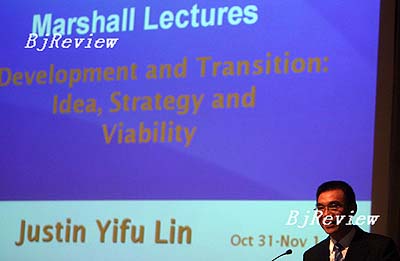|

"Development and Transition: Idea, Strategy and Viability" is the title of a lecture given by Justin Yifu Lin, professor at the China Center for Economic Research of Peking University, when he spoke at the Cambridge University-sponsored Marshall Lectures from October 31-November 1. In his talk, Lin elaborated on the successes and failures of China's economic transition along with those of other developing countries. Excerpts follow:
East Asian economies seem to be rather special in terms of their development and transition performance since World War II. Development "miracles" occurred in the newly industrialized economies in East Asia and transitional miracles in China and Viet Nam.
As discussed, China, Viet Nam and other East Asian economies adopted a dual-track, gradual approach in their transition from centrally planned to market economies, which violated the basic tenets of the Washington Consensus and shock therapy. In effect, for its transition from a wartime economy after World War II, Japan also adopted a gradual approach, whereas Germany adopted a big-bang approach. In terms of development policies in Korea and Taiwan, both governments initially adopted a policy mix--including financial repression, overvalued exchange rates, deficit budgets and neglect of the agricultural sector--to support the development of labor-intensive primary manufacturing industries to substitute the imports of manufactured household products--referred to as "primary import substitution." The policy package was typical in countries that adopted a comparative advantage-defying (CAD) strategy.
It was not, however, the intentional choice of the government in Japan and other East Asian economies to follow a comparative advantage--following (CAF) strategy in pursuit of economic development. Governments in East Asia also had a strong desire for the development of advanced capital-intensive industries--just like governments in other developing countries in the 1950s and 1960s. Their economies were, however, relatively small in population size and their natural resource endowments were extremely poor, which greatly constrained their ability to mobilize enough resources to subsidize the non-viable enterprises in the capital-intensive industries in the early stage of their development. In the early 1950s, Taiwan was influenced by the fashionable post-war development thinking and tried to protect and subsidize the development of heavy industries by using quantitative restrictions, tariff barriers and subsidized credits via strict regulation of banks and other financial intermediaries. The attempt, however, caused severe budget deficits and high inflation. The government in Taiwan had to give up the attempt and devalued its currency, liberalized trade and raised the real interest rate to encourage savings and contain inflation. Without preferential protection and subsidization, industrial upgrading in Taiwan followed closely the changes in its comparative advantages.
A CAD strategy is very inefficient. How long such a strategy can be maintained depends on the level of resources the government can mobilize to subsidize the non-viable enterprises and to support the investment in the prioritized industries. Resource mobilization is constrained by the natural resource endowment and population size. Contrasting with the case of "resource curse" in many parts of the developing world, the East Asian economies were lucky in the sense that their governments needed to be pragmatic in their policies and unintentionally follow a CAF strategy--even though their governments had strong motivations for nation building. China's Confucian culture--which has a strong impact in East Asia-is pragmatic in nature. The core of Confucianism is zhongyong, the golden mean, which advises people to maintain balance, avoid extremes and achieve harmony with the outside, changing world. The political philosophy and policy principles promoted by the Communist leadership of Mao Zedong, Deng Xiaoping and Jiang Zemin, Hu Jintao are, respectively, shishiqiushi (finding truth from the facts), jiefangsixiang (freeing one's mind from dogmatism), yushijujin (adapting to the changing environment) and hexie (harmony)--all reflecting the traditional Chinese culture of zhongyong.
Before I answer the question of whether East Asia's success, especially its transitional experience, has a general implication for other developing and transitional economies, I need to provide an analysis of the failure of gradual reforms in Poland, Hungary and the former Soviet Union in the 1980s before their adoption of shock therapy. They also tried to reform their planning systems by giving state-owned enterprises more autonomy. Their partial reforms did not, however, have the positive results of the reforms in China and Viet Nam. A number of explanations are in order. First, unlike in China and Viet Nam-where state-owned enterprises, after fulfilling their plan obligations, were allowed to sell their extra outputs at market prices-the enterprises in Eastern Europe and the former Soviet Union were not allowed to set their prices. This price rigidity meant that excess demand and chronic shortages remained and the state producers did not have the incentives to allocate their products to more efficient users, who would then have been able to pay higher prices for their products.
|
